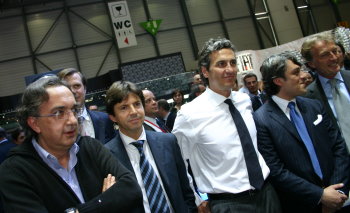|
At its scheduled Annual General Meeting on 18 April 2007 the Board of
Directors of Swiss-based giant international banking and investment firm UBS will propose
Fiat CEO Sergio Marchionne for election to the board as a
non-executive member.
Sergio Marchionne, born in 1952, is Chief Executive Officer of Fiat S.p.A.,
Turin, as well as Fiat Group Automobiles.
Marcel Ospel, the Chairman of the Board of UBS, commented: "Sergio Marchionne
has gained extensive leadership experience in a number of globally-active
companies covering different industries. I am extremely happy that he is willing
to stand for election to our board."
Sergio Marchionne earned his MBA at the University of Windsor, Canada, and his
law degree at Osgoode Hall Law School in Toronto, Canada, and is a lawyer and
chartered accountant. He is a citizen of both Italy and Canada.
The Board of Directors will also ask the AGM to re-elect Stephan Haeringer,
Helmut Panke and Peter Spuhler to the board, as their terms of office will
expire in 2007. After having served for six years on the Board of Directors of
UBS, Sir Peter Davis’ term will expire at the 2007 AGM. As he has reached the
statutory age limit, he will not stand for re-election.
After the 2007 AGM, the Board of Directors should again have 12 members, which
is the maximum number permitted by the UBS Articles of Association.
Today's UBS is
one of the world's biggest financial players and stems from
the merger announced on 8 December 1997 between Union Bank of
Switzerland (Zurich) and Swiss Bank Corporation (Basel) to form UBS AG became
reality on 1 July 1998.
Swiss Bank Corporation (SBC; Schweizerischer Bankverein, Société de Banque
Suisse, Società di Banca Svizzera) was founded in 1872 under the name Basler
Bankverein, and had its registered office in Basel. In 1897 the bank changed its
name to Schweizerischer Bankverein. SBC opened its first branch abroad in London
as early as 1898, an indication of its early emphasis on foreign operations. The
New York agency was opened in 1939. Although the bank opened branches in other
regions of Switzerland at the start of the 20th century, its major nationwide
expansion followed only in the 1960s.
In 1945 SBC took over the troubled Basler Handelsbank, one of Switzerland’s big
banks, founded in 1862. Within Switzerland, SBC traded as a
so-called universal bank with distinctively Swiss
characteristics.
|
 |
|
Today's
UBS is one of the world's biggest financial players
and stems from the merger announced on 8 December 1997 between Union Bank of
Switzerland (Zurich) and Swiss Bank Corporation (Basel) to form UBS AG became
reality on 1 July 1998. |
|
|
 |
|
Sergio Marchionne will
join the board of UBS next month. Photo: Marchionne
at the Geneva Motor Show earlier this month along
with Olivier François, Antonio Baravalle, Luca De
Meo and Luca di Montezemolo. |
|
|
At home it is involved with domestic corporate and retail
clients and asset management; whereas abroad, it
concentrated mainly on commercial banking for corporate
clients. In the last decade of the twentieth century, SBC
strengthened its international orientation again by taking
over foreign finance firms (1995: O’Connor & Associates,
Chicago; Brinson Partners, Inc., Chicago; S.G. Warburg plc, London).
In 1997, its last full trading year, SBC’s total assets amounted to CHF 438.9
billion. The Swiss network had 288 branches and there were 77 offices outside
Switzerland. The bank employed a total of 27,565 staff.
Union Bank of Switzerland (UBS; Schweizerische Bankgesellschaft, Union de
Banques Suisses, Unione di Banche Svizzere) was created in 1912 by the merger of
two regional banks: Toggenburger Bank, founded in 1863, and Bank in Winterthur
(1862). After World War One, UBS gained a foothold in several Swiss cantons by
taking over numerous banks and setting up its own branches, also turning to
foreign business. The years of crisis that followed had far-reaching effects on
UBS. In 1945 the bank moved its registered office to Zurich and acquired
Eidgenössische Bank (1862), one of Switzerland’s big banks, which was in
difficulties at the time. Only after the war did the first steps abroad occur,
with branches in London (1967) and New York (1975). Like Swiss Bank Corporation,
UBS was a typical representative of Swiss universal banking: at home, corporate
and retail clients and asset management; mainly commercial banking for corporate
clients abroad. In 1962, UBS’s assets totalled CHF 7.0 billion, and the bank led
the field among Swiss banks for the first time. Further important milestones
were the acquisition of Interhandel (1966) and of Phillips & Drew (1896) in
1985, the latter a British brokerage rich in tradition.
In its last full year of trading in 1997, UBS’s assets stood at CHF 557.6
billion. The Swiss business unit network ran to 357 branches with a further 82
branches abroad. The UBS Group employed 27,611 staff.
On 3 November 2000, UBS AG merged with PaineWebber Inc., a full-service
securities firm located in New York and founded in 1879.
|
|
|
|